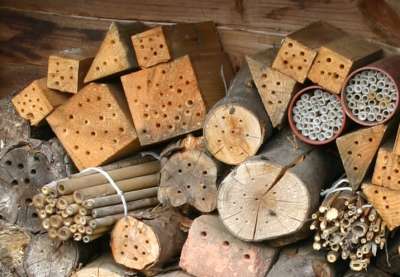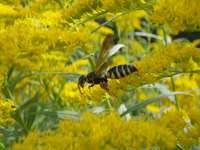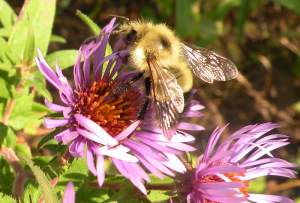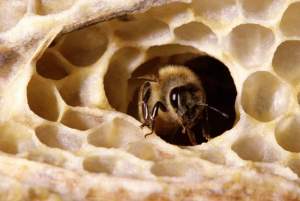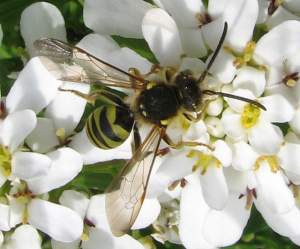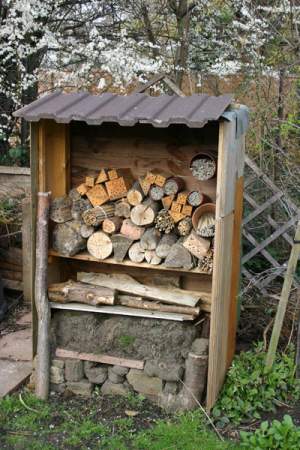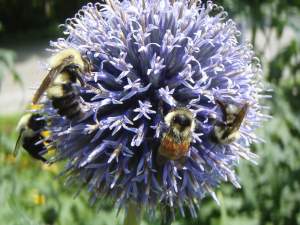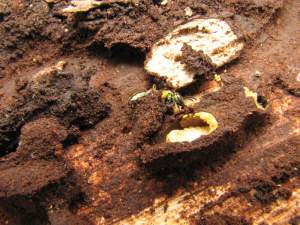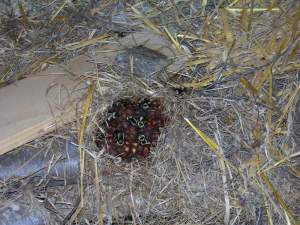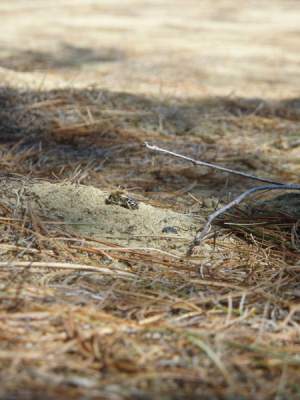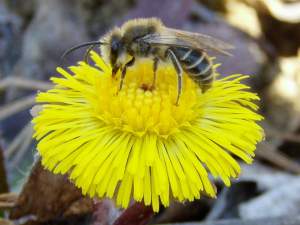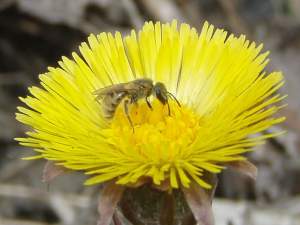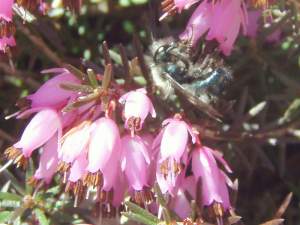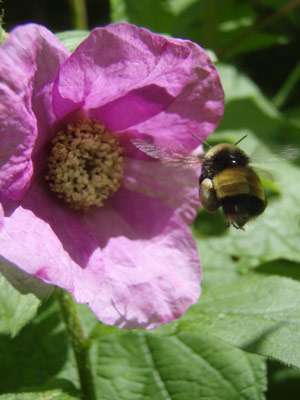
Plant life is an essential foundation of wildlife habitat. Whether in a northern hardwood forest or an agricultural landscape, plants form the base of the food chain, the structure of the habitat, and the cover necessary for many species of wildlife. Birds, mammals, and other animals rely on these plants, while most plants, in turn, rely on animal pollinators for their own reproduction. The role played by bees, flies, beetles, moths, butterflies, and other animals in moving pollen from one flower to the next is critically important, and the most important pollinators – by far – are bees.
The recent population crashes of commercial honeybee colonies have raised awareness of how important these insects are in pollinating agricultural crops. Similarly, many wild plants – blueberry, blackberry, serviceberry, and wild grape, to name a few – are just as dependent on animals, mostly bees, for pollination. Honeybees, like cows, are an agricultural animal imported by early European settlers from the Old World, but there are many species of wild bees that reside in the Northeast. While none of these native species produces enough honey for people to use commercially, they are nonetheless important pollinators of wild plants. And as honeybees decline, researchers are demonstrating that on many farms, unmanaged native bees such as bumblebees are becoming the most important pollinators of crops. This underscores the need to protect and manage habitat for these important insects.
More than 5,000 species of bees are native to North America, and about 400 of these are found in the Northeast. The natural history of these wild bees varies greatly, but all have one important habit in common: they feed their offspring pollen. In gathering this food from flowers, bees inadvertently transfer pollen grains from the anthers (the male organs of a flower) of one plant to the stigmas (the female parts) of the next, thus allowing the plants to form seeds and fruits.
Most bees will forage on a variety of plants and may thus benefit whole communities of flowering trees, shrubs, and herbs. Bumblebees are highly visible examples of this foraging strategy, readily switching from one type of plant – and habitat – to the next. On the other hand, about 20 percent of our bees are pollen specialists, meaning that they are adapted to gather pollen from just one plant family, genus, or even species. For example, a sweat bee known to science as Dufourea novaeangliae gathers pollen only from the anthers of pickerel weed; this bee is relatively common in the Northeast, but only around the marshes that are home to this plant.
In addition to pollen, most bees gather nectar from the flowers they visit. (Honey is made from this sweet plant secretion.) Some bees gather other plant products, too, including oils, resins, leaf tissue, and even odors.
Most of our wild bees are known as “solitary bees,” meaning that they lack the complex social structure of honeybee colonies. Females of these species establish solitary nests, provision their eggs with pollen (mixed with other plant products such as nectar and oils), then die before their offspring emerge. Though some solitary bees nest in communal aggregations, the adult bees have little interaction with each other. About one quarter of our solitary bees do not provision their own nests but rather lay their eggs in the nests of other types of solitary bees. These “cleptoparasites” lack many of the adaptations bees have for collecting and carrying pollen, such as abundant body hair and pollen “baskets,” or scopas, on their hind legs. Instead, they have spines, armored body segments, and especially large stings that protect them from angry hosts; their larvae are adapted to develop quickly and often kill the host’s offspring.
By contrast, the societies of our social bee species feature cooperation, a division of labor, and much communication. The most visible of these are the bumblebees. Each bumblebee queen establishes a new colony in spring or early summer, incubating a clutch of eggs that eventually develop into workers, who are nonreproductive females. The queen then stays in the nest laying eggs, while these workers travel the landscape gathering plant foods to feed successive broods of workers. Near the end of the season, the colony switches to production of males and fertile females – the fertile females are the following year’s new queens. The only members of a bumblebee colony to survive into winter are these new queens, who spend the cold months underground in a state of dormancy. Because these insect societies disband at the end of each growing season, they have no need to store large volumes of honey, as do the perennial colonies of honeybees.
Social bee species have their own parasites, known as social parasites. The female cuckoo bumblebees, for example, do not found their own colonies. Instead, they invade the nests of other bumblebees, where they kill the resident queen, subjugate the workers with pheromones, and lay their own eggs, which are tended by the original workers.
Habitat Requirements
Bees have three basic habitat requirements: nesting sites, overwintering sites, and access to the plant foods to which they are adapted. Most of our wild bees nest in tunnels they dig in sandy, silty, or loamy soils. Flat or gently sloping substrates are generally preferred, and the bees often choose areas with sparse vegetation. Examples of ground-nesting bees are the many species of mining bees (in the family Andrenidae) and sweat bees (in the family Halictidae). About one quarter of the bees in our area nest in the preformed cavities they find in twigs, acorns, snail shells, tree trunks, and other wood. Many of these bees seal their nests with “doors” made of chewed leaves, which has earned them the name “leafcutter bees” (the family Megachilidae). Bumblebees (in the family Apidae, with honeybees) nest in old rodent dens, above-ground cavities in dead trees, under tussocks of dry grass, in heaps of decomposing plant matter, and many other places. A small number of bees excavate their own nest cavities in sound wood. This includes the large carpenter bees, which are often considered pests for their habit of tunneling into the siding, soffits, and porches of our homes. Carpenter bees are common in southern New England but are only rarely found north of Massachusetts.
Bees and other pollinators need continuous access to an array of flowering plants throughout the growing season. Trees such as maples, willows, and apples are important sources of bee food in early spring. Spring wildflowers found in the understory of hardwood forests are critical to large numbers of bees that also pollinate the fruiting trees and shrubs many other animals depend on. Open wetlands feature many pollen and nectar sources for bees, including blueberries, cranberries, labrador tea, water lilies, and joe-pye weed. Late-summer flowering plants, such as asters and goldenrod, provide needed food toward the end of the growing season.
Adult bees do not migrate, and they are thought to seek winter shelter in underground cavities, hollow twigs, and other places that are protected, dry, and relatively stable in temperature.
Management Practices
Managing for bees and other pollinators involves many of the same practices employed for other wildlife. In general, habitat diversity will lead to bee (and other pollinator) diversity. You can promote floral diversity by maintaining a patchwork that includes mature forest, sunny openings, functioning wetlands, farms and gardens, and fields with areas that are not heavily cropped for corn or hay. Patches of wildflowers (clovers, fireweed, joe-pye weed, and purple flowering raspberry, for instance) on the margins of farm fields, lawns, and in hedgerows can be critical to bees, and should be maintained. Some invasive, non-native plants can be an excellent source of pollen and nectar for bees, while others may impoverish bee habitat by crowding out native flowering plants. Whenever possible, improvements to bee habitat should be made with native plants. There are native species of loosestrife (in the genus Lysimachia), as opposed to the invasive purple loosestrife.
Landowners should also consider the nesting needs of the bees at work on their lands. Leave parts of hayfields undisturbed, if it’s possible to forgo a portion of the crop. The sparsely vegetated and uncompacted soils of hedgerows, dry banks, and forest roads are often inhabited by nesting bees. Tilling can destroy bee nests, so in row-crop situations, leaving some areas fallow or in cover crop can help. One of the greatest threats to bees is the widespread use of pesticides. Of particular concern are the neonicotinoid class of pesticides, those applied to flowering plants, and those applied as dusts or small pellets, since bees mistake it for pollen and take it back home to feed their larvae.
In the woods, maintain an abundance of woody material, including logging slash, that might house cavity nesters. Encourage plants with pithy plant stems, such as sumac. When conducting habitat improvement work such as apple tree release, consider leaving some dead wood as nesting habitat for bees. And just as we provide nesting boxes for wood ducks and bluebirds, landowners can augment nesting habitat by providing blocks of wood with predrilled holes in them, as well as shoeboxsized wooden boxes for bumblebees. Finally, pay attention to the activities of bees on your property. Noticing trends in bee abundance on plants from year to year can help you evaluate whether you are receiving the valuable ecosystem service they provide.
What follows will help you become familiar with a few of the more obvious pollinators. One other way to know whether you have good bee populations is to monitor yields of fruit, cultivated or wild. Poor yields of apples, blueberries, and other fruiting plants may signal a need to attract more pollinators.
WHAT IS A BEE?
Everyone knows what a bee is, right? Well, in fact, many people are confused about how to distinguish bees from wasps and other winged insects. Technically speaking, both bees and wasps are insects in the order Hymenoptera, a group that also includes ants and sawflies. All bees share a common ancestor, and as a group, they are most closely related to wasps.
How to distinguish a bee from a wasp? Nearly all bees feed their offspring pollen, so most female bees have the habit of – and adaptations for – collecting and carrying it. If you see an insect collecting pollen from flowers, it is most likely a female bee. Most have obvious pollen-carrying brushes of hair or “baskets” on the segments of their hind legs or on the undersides of their abdomens. Wasps, on the other hand, provision their offspring with a variety of animal proteins. There is one interesting wasp group whose members collect pollen, but they don’t live in the Northeast.
Virtually all bees gather nectar at flowers, and many have elongated tongues designed for this purpose. Many wasps do the same, but they have very short tongues. Bees generally have obvious body hair, while wasps tend not to. In both bees and wasps, the females have stings, but many bees do not or cannot sting people.
Hornets and yellow jackets are well-known wasps that aggressively defend their nests from people. These wasps tend to have prominent yellow and black markings, few hairs, and obvious stings. Honeybees are the bees most of us are familiar with. They are hairy all over (even on their eyes) and feature a range of dark, tan, and honey-colored patterning on the abdomen. Bumblebees are usually larger and hairier than honeybees and often have bright color patterns created by patches of yellow, black, orange, brown, and red hair.
Many of our most common native bees – including sweat bees and mining bees – are smaller than a honeybee; many are dark in color, but others are bright metallic green or heavily striped. Leafcutter bees come in a variety of sizes and colors and feature prominent pollen-carrying brushes on the underside of the abdomen. Cleptoparasitic bees are often mistaken for wasps: they generally have few hairs, have no adaptations for collecting pollen, and may be brightly colored like the “typical” wasp.
Most birds and other predators learn to avoid eating wasps and bees because of the insects’ prominent yellow and black markings that signal their ability to sting. Many other insects that are otherwise defenseless have evolved similar color patterns in order to fool these predators. In the Northeast, flower flies and robber flies can closely resemble wasps or bees and may be found on the same flowers. A telltale sign that you are observing a fly is the presence of just one set of wings, rather than the two found on bees. Various moths and beetles also mimic wasps and bees.
Special Web Only Content
Welcome to Pollinator Paradise: Where bees and flowers cooperate for mutual benefit


